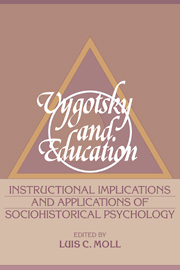Book contents
- Frontmatter
- Contents
- List of contributors
- Preface
- Acknowledgments
- Introduction
- Part I Historical and theoretical issues
- Part II Educational implications
- Part III Instructional applications
- 11 Changes in a teacher's views of interactive comprehension instruction
- 12 Learning to read and write in an inner-city setting: A longitudinal study of community change
- 13 Writing as a social process
- 14 Creating zones of possibilities: Combining social contexts for instruction
- 15 The zone of proximal development as basis for instruction
- 16 Detecting and defining science problems: A study of videomediated lessons
- 17 Assisted performance in writing instruction with learningdisabled students
- Name index
- Subject index
12 - Learning to read and write in an inner-city setting: A longitudinal study of community change
Published online by Cambridge University Press: 05 June 2012
- Frontmatter
- Contents
- List of contributors
- Preface
- Acknowledgments
- Introduction
- Part I Historical and theoretical issues
- Part II Educational implications
- Part III Instructional applications
- 11 Changes in a teacher's views of interactive comprehension instruction
- 12 Learning to read and write in an inner-city setting: A longitudinal study of community change
- 13 Writing as a social process
- 14 Creating zones of possibilities: Combining social contexts for instruction
- 15 The zone of proximal development as basis for instruction
- 16 Detecting and defining science problems: A study of videomediated lessons
- 17 Assisted performance in writing instruction with learningdisabled students
- Name index
- Subject index
Summary
This is a story about a group of people who want to provide their children with better educational opportunities. The people are black and live in an inner-city neighborhood of Chicago. Many of the children attend the local public school and join the ranks of peers who statistically do not do well in school and who fall below the national reading scores by the time they are in eighth grade. Many of the parents try to enroll their children in other public schools that tend to graduate children with better grades and higher reading scores, but community residents are still bothered by the fact that their local public school cannot seem to offer neighborhood families more promise for their children's education. Six years ago, leaders from the neighborhood community center sought help in finding out what they could do to improve education, particularly in the area of literacy development, both while their children attend Head Start and day-care programs at the community center and when they go to public school.
This research tells several stories. It is the story of the unique partnership between community people and myself, a university professor, established to facilitate change. It is the story of how storytelling and dramatics as conceived by teacher and author Vivian Paley have become the core of a literacy program for the Head Start and day-care programs.
- Type
- Chapter
- Information
- Vygotsky and EducationInstructional Implications and Applications of Sociohistorical Psychology, pp. 287 - 303Publisher: Cambridge University PressPrint publication year: 1990
- 9
- Cited by



